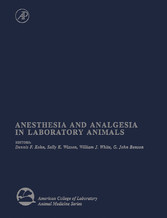Search and Find
Service
Front Cover
1
Anesthesia and Analgesia in Laboratory Animals
4
Copyright Page
5
Contents
6
List of Contributors
10
Preface
12
List of Reviewers for Chapters in This Volume
14
Definitions of Selected Terms
16
Chapter 1. Pharmacology of Injectable Anesthetics
20
I. Introduction
21
II. Barbiturates
21
III. Hypnotics
23
IV. Cyclohexamines: Dissociative Anesthetics
28
V. Steroids
30
VI. a2-Agonists
31
VII. Sedatives and Tranquilizers
33
VIII. Local/Regional Anesthesia
35
IX. Anesthetic Combinations
36
References
38
Additional Reading
46
Chapter 2. Pharmacology of Inhalation Anesthetics
48
I. Introduction
48
II. Chemical and Physical Properties
49
III. Mode of Action
54
IV. Uptake, Distribution, and Elimination
55
V. Inhaled Anesthetics
55
VI. Measurement and Quantification of Anesthetic Concentration for Research
57
VII. Health Risks Associated with Exposure to Waste Anesthetic Gases
59
References
59
Chapter 3. Pharmacology of Analgesics
62
I. Introduction
62
II. Nonsteroidal Anti-inflammatory Drugs
63
III. Opioids
67
IV. a2-Adrenergic Agonists
72
V. a2-Antagonists
73
VI. Analgesic Adjuvants
73
VII. Future Prospects
74
References
74
Chapter 4. Paralytic Agents
76
I. Introduction
76
II. Classification of Paralytic Agents
77
III. Measuring Neuromuscular Function
85
References
89
Chapter 5. Monitoring of Anesthesia
92
I. Introduction to Anesthetic Monitoring
92
II. Physiological Systems of Importance
93
III. Summary and Conclusions
99
References
100
Chapter 6. Monitoring of Analgesia
102
I. Introduction
102
II. Neuroanatomy and Neurophysiology of Pain
103
III. Mechanisms of Analgesia
105
IV. Pain Perception
105
V. Pain and Stress
106
VI. Determining When to Treat Pain
107
VII. Experimental Pain Models
114
References
118
Chapter 7. Anesthesia Equipment: Types and Uses
124
I. Introduction
125
II. Compressed Gases
125
III. Anesthetic Machines
127
IV. Breathing Circuits
137
V. Testing and Maintenance of Anesthetic Machines
140
VI. Ventilators
141
VII. Induction Chambers and Masks
145
VIII. Fluid Delivery Systems
147
IX. Monitors
148
X. Patient Support Equipment
157
XI. Ancillary Equipment
158
References
164
Chapter 8. Design of Surgical Suites and Postsurgical Care Units
168
I. Introduction
168
II. Design Considerations
169
III. Planning of Surgical Facility
173
IV. Construction of Surgical Facility
176
V. Conclusion
181
References
181
Chapter 9. Anesthesia and Analgesia in Rodents
184
I. Introduction
184
II. Unique Features of Rodent Anesthesia and Analgesia
185
III. Preoperative Patient Evaluation and Care
185
IV. Methods of Anesthetic Delivery/Equipment
186
V. Inhalant Anesthetics
188
VI. Parenteral General Anesthetics
192
VII. Regional Anesthesia
201
VIII. Intraoperative Anesthetic Monitoring and Support
201
IX. Postoperative Supportive Care
202
X. Acute and Chronic Analgesic Therapy
203
XI. Special Anesthetic Considerations
208
Appendix
210
References
219
Chapter 10. Anesthesia and Analgesia in Rabbits
224
I. Introduction
224
II. Preoperative Considerations
225
III. Methods of Delivery or Administration
227
IV. Parenteral Techniques
230
V. Inhalation Anesthesia
235
VI. Regional Anesthesia
236
VII. Special Anesthetic Considerations
237
VIII. Intraoperative Support and Monitoring
238
IX. Postoperative Considerations
239
X. Analgesia
240
Appendix
242
References
247
Chapter 11. Anesthesia and Analgesia in Nonhuman Primates
252
I. Introduction
253
II. Preoperative Evaluation
253
III. Anesthetic Delivery
254
IV. Anticholinergic Drugs
255
V. Parenteral Anesthetics
255
VI. Muscle Relaxants
259
VII. Inhalational Anesthetics
260
VIII. Intraoperative Monitoring
262
IX. Intraoperative Support
264
X. Special Anesthetic Considerations
264
XI. Postoperative Care
267
XlI. Summary
269
References
273
Chapter 12. Anesthesia and Analgesia in Dogs, Cats, and Ferrets
276
Introduction
277
Part A: Anesthesia and Analgesia in Dogs and Cats
277
I. Preanesthetic Evaluation
277
II. Delivery of Anesthetics and Adjunctive Drugs
278
III. Preanesthetic Medications
280
IV. Intravenous Agents for Induction or Maintenance of General Anesthesia
281
V. Balanced Anesthesia
285
VI. Overview of Inhalation Anesthesia
285
VII. Hemodynamic Effects of Inhalational Anesthesia
286
VIII. Methods of Inhalational Induction of Anesthesia
286
IX. Intraoperative Monitoring and Physiological Support
287
X. Postoperative Care
287
XI. Postoperative Analgesia
289
XII. Specific Considerations
290
References
292
Part B: Anesthesia and Analgesia in Ferrets
293
I. Introduction
293
II. Unique Features of Ferret Anesthesia
293
III. Preoperative Patient Evaluation and Care
294
IV. Methods of Anesthetic Delivery and Equipment
294
V. Sedatives and Tranquilizers
294
VI. Parenteral Anesthetics
294
VII. Inhalant Anesthesia
297
VIII. Regional Anesthesia
297
IX. Monitoring of Anesthesia
297
X. Intraoperative and Postoperative Supportive Care
298
XI. Acute and Chronic Analgesic Therapy
298
References
298
Chapter 13. Anesthesia and Analgesia in Ruminants
300
I. Introduction
301
II. Animal Health Considerations
302
III. Preparation for Anesthesia
305
IV. Local and Regional Anesthesia
307
V. Epidural or Spinal Anesthesia
308
VI. Pharmacologic Considerations for Anesthesia of Ruminants
309
VII. Sedation and Premedication
310
VIII. Induction of General Anesthesia
313
IX. Intubation Techniques
316
X. Maintenance of Anesthesia
318
XI. Monitoring of Anesthetized Ruminants
319
XII. Support during Anesthesia
321
XIII. Anesthetic Recovery and Postoperative Care
321
XIV. Pain Perception and Evaluation
322
XV. Pain Management
323
References
327
Chapter 14. Anesthesia and Analgesia in Swine
332
I. Anatomic and Physiologic Characteristics
333
II. Anesthetic Delivery
333
III. Inhalational Anesthesia
335
IV. Injectable Anesthetics and Tranquilizers
338
V. Regional Anesthesia
341
VI. Analgesia
341
VII. Intraoperative Support and Monitoring
342
VIII. Postsurgical Care
343
IX. Special Anesthetic Considerations
343
Appendix
349
References
352
Chapter 15. Anesthesia and Analgesia in Nontraditional Laboratory Animal Species
356
I. Introduction
357
II. Mammals
357
III. Birds
360
IV. Reptiles
367
V. Amphibians
378
VI. Fish
381
VII. Invertebrates
383
Appendix
386
References
386
Chapter 16. Postoperative Support and Intensive Care
398
I. Introduction
398
II. Facilities and Equipment for Postoperative and Intensive Care
399
III. General Nursing Care Protocols
399
IV. Personnel Training
400
V. Record Keeping
400
VI. Monitoring
401
VII. Postoperative Care
405
VIII. Nutritional Support
407
IX. Vascular Catheter Placement and Care
409
X. Fluid Therapy
411
XI. Conclusion
412
References
413
Chapter 17. Current Research in Anesthesia and Trends in Clinical Applications
416
I. Introduction
416
II. Novel Sites for Anesthetic Drug Action
417
III. Novel Drugs
420
IV. Anesthetic Delivery
422
References
424
Appendix
428
Index
430
All prices incl. VAT











